T&E recovery not until 2023, B2B will soar, predicts panel

Travel spend levels are unlikely to fully recover to pre-pandemic highs until 2023, claim commercial card industry leaders.
After Covid-19 prompted a record slump in travel and expenses (T&E) activity, the commercial payments industry is on the lookout for green shoots of recovery. Speaking on a panel at a CPI event, experts agreed that 2019 spending levels are not likely to be seen again for 3 years. The projections illustrate a significant shift in commercial spending trends and a realignment of priorities for the industry.
In 2019 global T&E spend hit a record high of $129bn, yet that figure will not be surpassed until when T&E will hit $130bn global commercial spend, according to new research. In the same period, B2B spend is projected to soar to $785bn in 2023 from $496bn in 2019.
According to Frank Martien, MD Commercial Payments, Accenture, commenting on global travel, ‘we believe up to 70% of overall business travels at risk’, and ‘we’re looking at a 60% reduction, at least in 2020, and at least a 30% reduction in 2021’. Modelling of current T&E spending will not see volumes return for 3 years: ‘we don’t see travel, corporate card and central travel accounts spend reaching the same level of 2019 until 2023’, due to ongoing Covid-19 impacts.

Declines in T&E spending are occurring in several sectors, including domestic and international air travel, currently down 47% and 69% respectively, with significant declines in business meetings, conference and incentive travel, which signals a structural change in the global business travel market, according to Accenture analysis.
In a global survey of 125 companies conducted by Citi, 94% of respondents said their companies had travel restrictions in place, 83% said that they would encourage virtual meetings after social distancing and 68% said that they were unsure as to whether they would attend large events or conferences. Presenting the survey results, Oscar Mangini, Citi, conceded that the recovery in travel might “take two years at the very least, and that some question whether we will be back at those dynamic levels of travel”.
The new normal
“Our T&E business is significantly down year on year, particularly in the large corporate sector,” says Barclaycard’s Maria Parpou. “Because SMEs typically use their cards for wider purposes, over and above T&E, the decline has been subtler in that sector – and we’ve subsequently seen marginal uptick for SMEs as the economy reopens.”

Commenting on the longer term prognosis for the industry, Parpou states that “even if a vaccine is found, many companies have now become accustomed to virtual meetings, so it will take some time to get back to the same levels of travel we saw before the Covid crisis.”
There are likely be regional variations to the recovery in T&E, claims Mangini, “the way that the pandemic progressed through the regions will probably dictate how travel returns”, with Asia opening up first, “we do see some signs of recovery in Asia and especially in China”, he notes.
With many hoping for a holiday after lockdowns, “leisure bookings will be a good indicator to evaluate the appetite of the population for travel in general, and for business travel to initiate a recovery” says Mangini, adding that “50% of Citi respondents believe that domestic travel will pick up before international travel”.
For those in the events industry, there is a glimmer of optimism from Mangini: “nothing replaces face to face interaction, especially when you’re trying to establish business relationships” he said. “However, large conventions and conferences might take a while to come back.”
For the commercial card industry, the dramatic drop in T&E volumes, down $54bn to $75bn in 2020, represents a 42% decline, according to Accenture, with a further 25% margin of error in that estimate due to the unpredictability of the ongoing pandemic.
The pivot to virtual
This decline will more than be offset by the rise in B2B activity, claim the panel. “B2B e-commerce in particular is a growth area”, says Martien, predicting that B2B commercial card volumes will grow 37% to $785bn in the period to 2023.
Parpou says that the B2B trend is already underway; “B2B payments are business as usual, with these payments staying steady throughout. We strongly believe B2B payments will be a growth area in the future.”

Mangini agrees, that there is an increasing uptick for B2B products “virtual solutions, reconciliation and automation” are all in demand, where “use cases are enabled by virtual card, married to a mobile solution” with a preference for “contactless solutions and non-physical card solutions”.
For Martien, the acceleration in B2B payment solutions will drive acquisition activity: “as issuers and networks develop these products, it also may be evidenced by some of the M&A activity in fintechs, to help build those B2B e-commerce capabilities”.
“Fintechs focussed on T&E will also pivot to B2B” as a necessary strategy for growth, “and will need to seek other business ventures to keep revenue growing”, suggests Mangini.
Parpou agrees that the shift to e-commerce has accelerated; “many merchants have moved online, catering for consumers but also for business customers. This creates an opportunity to promote B2B payments in the wider ecommerce ecosystem.”